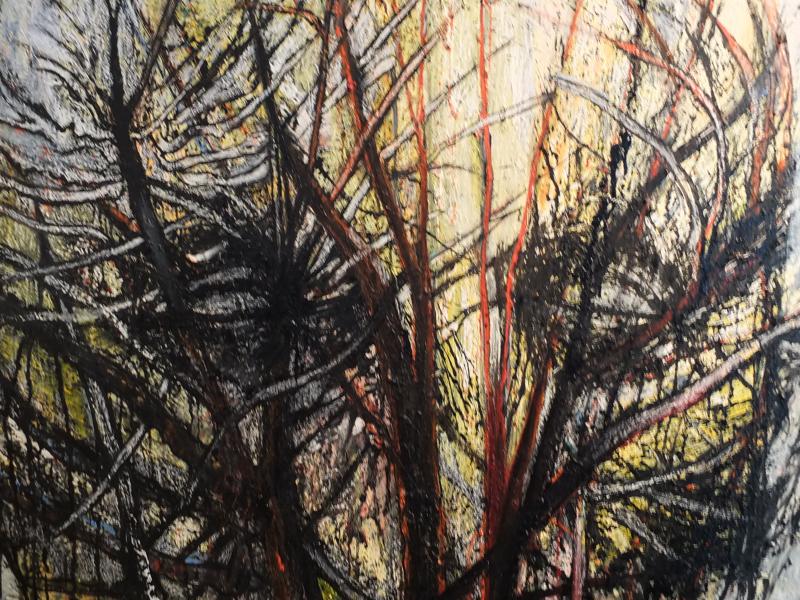“I was thrilled out of my mind. Monhegan was a major experience, my refuge,” said Leonard Meiselman. “I have been returning to Monhegan for 59 years, since the mid-1950s, to draw, paint and write about trees.”
Originally from New York City, Meiselman cites Monhegan Island as a major influence in his art, in his spirituality, and his connection to nature.
For several years he has noted the number of fallen, or dying, trees increasing on the island. “Last year was the worst it had looked. And, my favorite places (Burnt Head among them) … I couldn't find them,” Meiselman said. “The devastation was so horrendous. The trees are dying. Why?”
Anyone who has been to Monhegan over the past few years has observed the increased number of fallen, dying trees or partially dying trees fighting to continue standing tall. But poor soil, increasingly harsh winters, air pollution, acid rain, global warming and new invasive plant and insect species have all played a role in the demise of the coastal forests.
According to forestecologynetwork.org, “what we are witnessing across most of eastern North America is a pandemic of tree death.”
There are many theories about why the trees are dying, including “nature knows best.”
The many questions about the state of the forests led the artist to organize an art exhibition, poetry readings, and a panel discussion with foresters, ecologists, and others to explore the question and to, perhaps, find some answers. But above all else, Meiselman hopes to raise public awareness of the situation facing not only Monhegan, but all of Maine's coastal forests. These events are at Curtis Memorial Library in Brunswick.
Of Meiselman's 21 works in his show, “A Protest Artist on Monhegan,” half were begun while he was on the island in the spring of 2015, with particular attention paid to the white spruce, and half were done in prior years.
Meiselman said using new and existing works in this exhibition creates a more inclusive representation of some of the work he has done on Monhegan. Eight years ago, he published a book entitled, “A Monhegan Journal,” filled with his journal entries, drawings, paintings and photos. Copies of the book are in the Monhegan library and the museum. View it on the artist's website, www.lmeiselman.com/monhegan3.html.
When viewing this artist's work, one can expect to experience the depth of emotion within Meiselman while painting, transferred to the canvas through his paint brush.
“On Island,” Meiselman admits is a self portrait. In it, Meisleman's anguished soul residing amongst the trees he so loves. He and the trees are one.
“On Island ... yes, it's how I feel; yes. its a bit romantic, there's a tenderness to it representing my emotional truth of being on Monhegan Island historically,” Meiselman said.
This painting reflects the artist's soul and represents the oneness of the man and the trees. The skin of the face is bark-like, the rings under the eyes could be likened to the rings of a tree's trunk which reveal age, but in this case, represent the decades spent returning to Monhegan to paint and draw the trees.
This is the first time he has ever painted human features in his paintings of trees. Perhaps, too, seeing those human eyes, reflectors of the soul, the life force, will make it easier for viewers to think of trees as being alive, and as living parts of nature fighting to stay alive.
In “Rain,” the last, and one of the largest, paintings in the show, a tree fights to remain standing against the elements. The dots of red in the painting remind one of tree sap. In “Rain,” the primary tree is a bleeding tree. But, there is hope — represented in the blue and lightening of the sky. The tree trunk is slightly bent, it has begun to yield to the elements, but the tree's spirit continues to fight to stay alive.
There is no single answer. There isn't a simple answer.
Clearing fallen trees to make room for new growth would be a start - and help to avoid fires. Reclaiming trails would be another starting point. And volunteers to help with the work would be a real boon.
Visit the Morrell Meeting Room at Curtis Memorial Library, located at 23 Pleasant Street in Brunswick, and take in the latest works of this protest artist as he calls for your attention to the plight of the trees. Attend the poetry reading on Friday, Jan. 22 at 7 p.m. with Gary Lawless, Terry Grasse, Stephen Petroff, Pam Smith, Ellen Taylor and Kristen Lindquist.
Attend the “Spruce and Saltwater” panel discussion with Ken Laustsen, Jack Witham, Philip Conkling, and Lloyd Irland on Jan. 27 at 5 p.m. about the state of Maine's coastal forests.
All of these events are free.
“Artists,” said Meiselman, “bear witness. And while we are creating, we hope we are creating an awareness of a situation or cause. We have to take care of the earth - and embrace her.”
For more on this Wiscasset based artist: http://www.boothbayregister.com/article/attempting-understand-holocaust-...

































